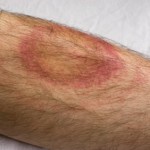Yesterday's edition of The New York Times had an article by an experienced academic physician that called for a new Lyme disease vaccine, Dr. Stanley A. Plotkin, a professor of pediatrics at the University of Pennsylvania said new CDC data had been released showing a ten-fold greater incidence of the disease than was previously thought. He explored the history of the vaccine put on the market in 1998 by a major US pharmaceutical company, then called SmithKlineBeecham (now it's become GlaxoSmithKline).
I looked for that news release from the CDC and found their old numbers in an August, 2013 online site (30,000 cases a year reported by state and DC health departments) had been superseded by new preliminary figures coming from three different databases. So instead of the numbers we've thought represented human cases, 96% of which occur in thirteen states in the Northeast and upper Midwest, we have 300,000 cases a year, still heavily concentrated in those regions.
In 2011 Richard Ostfeld, a senior disease ecologist working at the Cary Institute in New York published an excellent book, Lyme Disease: The Ecology of a Complex System, aimed at a mixed readership of scientists and nonscientists. I've mentioned this before but should reiterate his finding that white-footed mice were a highly significant reservoir (host animal) for the bacteria that is then transmitted to humans by, in this country, one particular insect-like species, the black-legged tick.It's actually an arachnid, cousin to spiders and scorpions. There are other host species and a variety of predators, weather/climate conditions and habitat factors also play a role.
His work predicted a surge in cases of Lyme disease in the spring of 2012, based on an acorn crop boom-and-bust cycle. The town of Whitman, MA, published an online summary of this prediction quoting the Cary Institute's press release. In brief that mouse species' population soars in a year with an abundant acorn crop and falls markedly when acorns are scarce. The organism that causes Lyme disease is a bacterial species called Borrelia burgdoferi, The white-footed mouse is a superb host for that bug; the mouse doesn't get sick; the bacteria multiplies and there is an abundant supply of B. burgdorferi waiting to spread to other animals. Those mice are also frequently bitten by the tick in question, especially around their ears.
In the seasons of acorn abundance the mouse population soars and the ticks, which need a blood meal three times in their life span (once in the larval storage, once as a nymph and once as an adult), have plenty of mice to feed on.
But then comes a lean crop year for the acorns and the B. burgdorferi infected ticks have to find other blood sources for their next meal. Any mammal will do, but humans are certainly among those available. If we are camping or hiking through an area where the tiny tick nymphs or abound, we may never notice the bite. We may not even be wearing any bug spray or perhaps have more skin exposed than is safest. The nymphs are cold-blooded, so the countryside has to warm up from Winter's blasts before they are ready to feed. If it's a milder cold season (and with global warming that may be the case), the nymphs may be out looking for a meal as early as April.
Forest ecologists from the Cary Institute noted 2010's crop of acorns was very heavy; mouse population numbers rose appropriately. Then, in the fall of 2011, their research site had a marked acorn scarcity. Mouse numbers plummeted leading to a prediction from the group of at least 20% more human cases of Lyme disease.
Let's return to Dr. Plotkin's article in the New York Times. Eight years ago he almost lost an adult son to a cardiac complication of a Lyme infection. Alec D. Plotkin was walking his dog on an August day in Pennsylvania when he abruptly lost consciousness and collapsed. In 2011 his father (Dr. Plotkin) published an article, "Correcting a Public health Fiasco: The Need for a New Vaccine against Lyme Disease," in the Journal Clinical Infectious Diseases. At that time the yearly US case estimate was (reported cases only) roughly 20,000, but as Dr. Plotkin noted, "the extent of underreporting is unknown." He mentioned that the state of Connecticut's statistics would imply that 1% of its entire population could develop the ailment over a ten-year stretch and that nine of sixteen countries in Europe, where Lyme disease is caused by a different variant of B. burgdorferi, had data showing an increased case incidence over time.
On Septmeber 19, The New York Times published the obit of Dr. Stephen E. Malawista, who, as chief of rheumatology at Yale School of Medicine had, with his postdoctoral student, Allen C. Steere, defined Lyme disease. In the fall of 1975 two women from Lyme, CT and Old Lyme had developed joint swelling, peculiar rashes and neurological complaints undiagnosable by their local physicians. Each went to Yale seeking answers.
Researchers there noted that the clinical picture, which was originally felt to be juvenile rheumatoid arthritis, had occurred in clusters and at a rate 100 times that expected for JRA. It also was clustered in warm-weather months. Dr. Malawista suggested the name Lyme arthritis and he and his team made the eventual linkage with tick bites. In 1982 Dr. Willy Burgdorfer found the bacterium responsible and Yale scientists wnet to work to develop a vaccine.
It was finally licensed in 1998, but a series of events, detailed by Dr. Plotkin in his medical article, led to it being removed from the market four years later. In brief: the CDC's Advisorty Committee on Immunization Practices (ACIP) gave greater emphasis to protective clothing, tick repellants and, in the event of an infection, consistent early diagnosis and antibiotic treatment, than to the vaccine, even for those at high risk. Then it was only tested in adults and more in the group who got the vaccine than in the control group experienced some transient joint soreness...but not actual arthritis (typically red,hot, swollen, painful joints. The marketing of the drug was inappropriately directed at a lay, not a medical audience. A class action suit was brought against Glaxo, the drug company which produced the vaccine and, in spite of later studies showing no increase in Lyme-related joint disease, was settled by Glaxo for $1 million in 2003. Only the lawyers involved got any money.
By then the vaccine was off the market.
It's clearly time for it to come back, perhaps in a new version, perhaps developed by a different company, but, in any case a human Lyme disease vaccine is needed.





